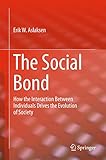The Social Bond [electronic resource] : How the interaction between individuals drives the evolution of society / by Erik W. Aslaksen.
By: Aslaksen, Erik W [author.] .
.
Contributor(s): SpringerLink (Online service) .
.
Material type:  BookPublisher: Cham : Springer International Publishing : Imprint: Springer, 2018Edition: 1st ed. 2018.Description: VIII, 235 p. 50 illus. online resource.Content type: text Media type: computer Carrier type: online resourceISBN: 9783319687414.Subject(s): Dynamics
BookPublisher: Cham : Springer International Publishing : Imprint: Springer, 2018Edition: 1st ed. 2018.Description: VIII, 235 p. 50 illus. online resource.Content type: text Media type: computer Carrier type: online resourceISBN: 9783319687414.Subject(s): DynamicsIntroduction -- Evolution -- The Individual - the Basic Component of Society -- Interaction -- Models -- Implications and Conclusion.
This book is open access under a CC BY 4.0 license. This authored monograph analyses the determining factors of societal evolution: the interaction between individuals and the resulting relationship, which the author calls the "Social Bond". The book aims at providing a better understanding of social dynamics and social interaction, and the author develops two models which provide interesting new insights. The target audience primarily comprises academics working in the field of social complexity and related fields, but the book may also be beneficial for graduate students alike.


There are no comments for this item.